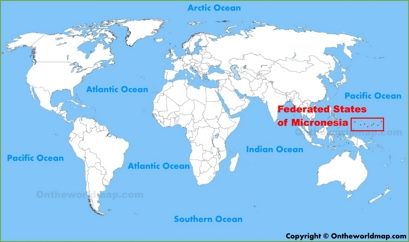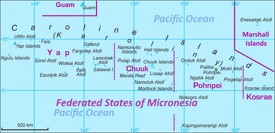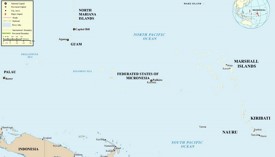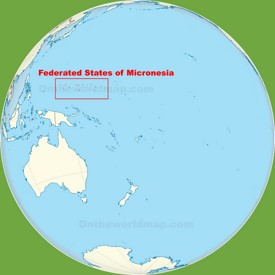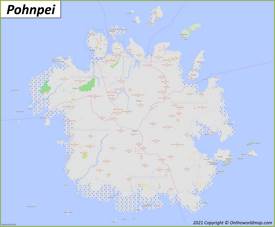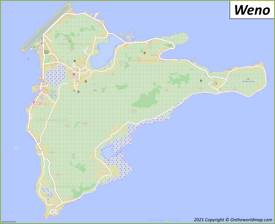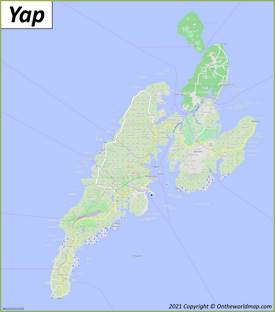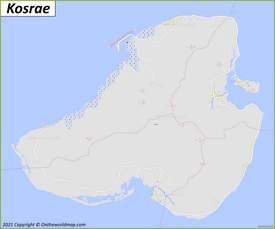Micronesia Map
Description:
This map shows governmental boundaries of countries, islans, states, and state capital cities in Federated States of Micronesia.
Size: 2000x1071px / 337 Kb
Author: Ontheworldmap.com
You may download, print or use the above map for educational, personal and non-commercial purposes. Attribution is required. For any website, blog, scientific research or e-book, you must place a hyperlink (to this page) with an attribution next to the image used.
Online Map of Federated States of Micronesia
Detailed Maps of Federated States of Micronesia
About Federated States of Micronesia
The Federated States of Micronesia (FSM) is an island nation located in Oceania, in the western Pacific Ocean, northeast of Papua New Guinea and Indonesia, south of Guam and the Marianas, west of Nauru and the Marshall Islands, east of Palau and the Philippines. The capital is Palikir, located on the island of Pohnpei, and the largest city by population is Weno on the island of Chuuk.
The state consists of four states, Yap, Chuuk, Pohnpei, and Kosrae, comprising more than 600 islands with an area of about 271 square miles (702 square kilometers). The population of FSM is about 115,000, and the ethnic groups (Chuuk, Pohnapei, Kosrae, Yap, outer islands Yap, and others) and languages reflect the complex cultural makeup of the country.
FSM's economy relies heavily on United States financial assistance, tourism, fisheries, and agriculture. Coconut, tapioca, fruits and vegetables, bananas, and black pepper are cultivated. Goats, pigs, dogs (for meat) and chickens are raised. A Compact of Free Association with the United States provides substantial funding and economic support. The country mainly exports fish and seafood, particularly tuna, and imports fuel, food, machinery, and manufactured goods.
Infrastructure development remains a challenge due to the scattered nature of the islands over a large area, and stretching nearly 2,700 kilometers (1,700 miles) in length. However, the FSM continues to focus on improving transportation and communication networks to facilitate economic growth.
The Facts:| Capital: | Palikir |
| Area: | 271 sq mi (702 sq km) |
| Population (2019): | ~ 104,468[1] |
| Official language: | English |
| Currency: | United States dollar (USD) |
| Driving side: | right |
| Calling code: | +691 |
| Internet TLD: | .fm |
| Time zone: | UTC+10 and +11 |
| Gross domestic product 2019 (PPP): |
|
| Gross domestic product 2019 (nominal): |
|
Largest cities: Weno, Colonia, Kolonia, Tofol.
States of Micronesia: Yap, Chuuk, Pohnpei, Kosrae.
Islands of Micronesia: Kosrae, Pohnpei, Weno, Yap, Chuuk Atoll, Eauripik, Elato, Falalop, Mokil Atoll, Namonuito Atoll, Nomoi Islands, Etal Atoll, Losap, Hall Islands, Nomwin, Murilo, Lukunor, Faraulep, Fayu Atoll, Gaferut, Ifalik, Kapingamarangi, Kuop, Lamotrek, Lelu Island, Nama, Namoluk, Ngulu Atoll, Nukuoro, Pakin Atoll, Sorol, Ulithi, Woleai, Olimarao, Oroluk Atoll, Pakin Atoll, Piagailoe, Pingelap, Poluwat, Pulap, Sapwuahfik, Satawal, Satawan, Senyavin Islands, Ant Atoll.
Geography of Federated States of Micronesia
The Federated States of Micronesia (FSM) are located in the western Pacific Ocean. It consists of more than 600 islands, including high volcanic islands and low-lying atolls. The FSM is located between 1 and 10 degrees north latitude, giving the islands a tropical climate characterized by high humidity and year-round temperatures of 77 to 88°F (25 to 31°C).
Rainfall varies considerably across the islands, with Pohnpei receiving the highest annual rainfall, often exceeding 200 inches (5,080 mm). The wet season on the islands lasts from May through November, and the relatively dry season lasts from December through April. The geographic diversity of the FSM includes the mountainous regions of Pohnpei and Yapa, extensive lagoons on Chuuk, and lush rainforests on Kosrae, providing diverse ecological habitats and natural resources.
Brief History of Federated States of Micronesia
The history of the Federated States of Micronesia (FSM) is marked by diverse cultural and political influences. Settlers from Southeast Asia arrived more than 4,000 years ago, establishing complex societies with advanced navigational skills. European contact began in the 16th century, and Spain took control of the territory in the late 19th century. After the Spanish-American War, Germany acquired the islands in 1899.
During World War I, control of the islands passed to Japan, which administered the region under a League of Nations mandate. After World War II, control of the islands passed to the United States under the tutelage of the United Nations. The FSM gained independence in 1986 through the Compact of Free Association with the United States, which provided economic aid and defense. This agreement established the FSM as a sovereign nation while maintaining close ties to the United States.


